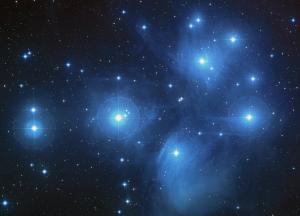Blog
Anomaly of Hipparcos
2 December 2013
 NASA/ESA/AURA/Caltech
NASA/ESA/AURA/CaltechThe Pleiades is an open cluster that is easily seen in the night sky as a group of six (sometimes seven) stars in the constellation of Taurus. It mostly contains bright blue (B-type) stars, and is about 440 light years away. Or about 380 light years. Or perhaps somewhere in between.
On a cosmic scale, a few hundred light years is in our back yard. It is only about 100 times more distant than the closest star to the Sun, so this cluster is very close. Given that we measure distances to much more distant objects with good accuracy, why don’t we know the distance to the Pleiades? It all has to do with an interesting result known as the Hipparcos anomaly.
There are lots of ways we can measure the distances of stellar objects. One way, is to look at small main sequence stars in the cluster at infrared wavelengths. From this you can gauge the actual brightnesses of the stars (absolute magnitude) and compare them the apparent brightnesses (apparent magnitude) to determine their distance. This gives a distance of about 435 light years. Another is to look at the motion of a binary star in the cluster. You can gauge their masses by their temperatures, and then use their orbital motion to determine their distance. This gives a distance of about 430 light years.
But the Pleiades is close enough to determine their distance by parallax. If you hold your thumb out in front of you and look at it from one eye, and then the other, you will see an apparent shift of your thumb relative to more distant objects. This shift is known as parallax, and we can use the effect to determine the distance to nearby stars.
Of all the different methods, parallax should be the most accurate. However, when the High Precision Parallax Collecting Satellite (Hipparcos) measured the parallax of the Pleiades, it determined a distance of 385 light years. This is significantly different from other measurements. So different in fact, that if it is accurate, the stars in the Pleiades must be anomalously dim. Much dimmer than similar stars of the same temperature.
Since parallax is a more direct observation of stellar distance you might be inclined to accept the Hipparcos distance over the other measurements. But after the Hipparcos observations, the Hubble space telescope made parallax observations of three stars in the cluster, and found a distance of 440 light years. Ground based parallax observations also give a similar distance.
The Hubble and ground-based parallax observations are supposed to be less accurate than Hipparcos, but they agree with all the other observations. A wide range of observations, including parallax observations, give a distance to the Pleiades in the range of 425 – 440 light years. Hipparcos disagrees with all of them, and came to be known as the Hipparcos anomaly.
So which one is right? Despite the fact that Hipparcos was supposed to give the best result in the most direct way, it seems that Hipparcos is wrong. In a 2012 paper in Astronomy Letters1 a comparison was made between Hipparcos distance calculations of various star clusters and the distances calculated by kinematic methods. What they found was that the Hipparcos results for clusters are consistently closer than they should be. It seems there is a systematic bias in the Hipparcos data when it comes to star clusters.
Currently the best distance calculation is taken to be about 425 light years. The Hipparcos anomaly isn’t really an anomaly, but rather a cautionary tale about the complexities of data analysis and how systematic biases can arise in your results. This is why we keep testing things, and why we love to have multiple techniques when determining distances.
Francis, Ch, and Erik Anderson. “XHIP-II: Clusters and associations.” Astronomy Letters 38.11 (2012): 681-693. ↩︎